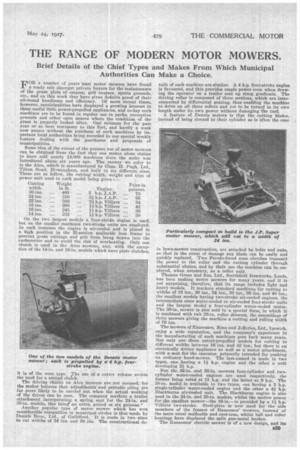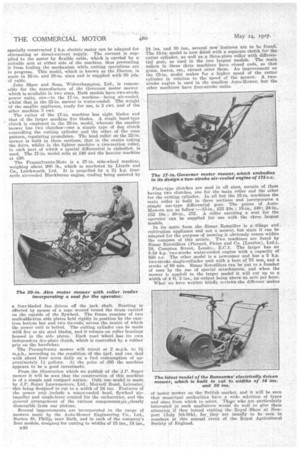THE RANGE OF MODERN MOTOR MOWERS.
Page 129

Page 130

If you've noticed an error in this article please click here to report it so we can fix it.
Brief Details of the Chief Types and Makes From Which Municipal Authorities Can Make a Choice.
FOR a number of years past motor mowers have feund a ready sale amongst private buyers for the maintenance of the grass plots of estates, golf courses, sports grounds,. etc., and on this work they have given definite proof of their all-round handiness and efficiency. Of more recent times, however, municipalities have displayed a growing interest in these useful little power-propelled appliances, and to-day such machines are to be found in regular use in parks, recreation grounds and other open spaces where the condition of the grass is properly looked after. Our columns for the past year or so bear testimony to this 'fact, and hardly a week now passes without the purchase of such machines by important local authorities being recorded in our special weekly feature dealing with the purchases and proposals of municipalities.
Some idea of the extent of the present use of motor mowers can be obtained from the fact that one maker alone claims to have sold nearly 14,000 machines since the make was introduced about six years ago. The mower we refer to isthe Atco, which is manufactured by Chas. IL Pugh, Ltd., Tilton Road, Birmingham, and built in six different sizes. These are as follow, the cutting' width, weight and type of power unit used in each model being given
On the two largest models 'a four-stroke eivine is used but on the smaller machines two-stroke units are employed. In each instance the engine is air-coaled and is placed in a high position in the la-section malleable iron frame to prevent grass cuttings and grit from being drawn into the carburetter and to avoid the risk of overheating. Only one clutch is used in the Ate° mowers, and, with the exception of the 14-in. and 16-in, models which have plate clutches,
tails of each machine are similar. A 4 h.p. four-stroke engine is favoured, and this provides ample power even when drawing the operator on a trailer seat up steep gradients. The driving roller is composed of three sections, which are interconnected by differential gearing, thus enabling the machine to drive on all three rollers and yet to be turned in its own length under its own power without damaging the turf. A feature of Dennis motors is that the cutting blades, instead of being riveted to their cylinder as is -often the case
in lawn-mower construction, are attached by bolts and nuts, so that in the event of damage any blade can be easily and quickly replaced. Two Ferodo-faced cone clutches transmit the power to the roller and the cutting cylinder through substantial chains, and by their use the machine can be employed, when necessary, as a roller only.
Thomas Green and Son, Ltd., Smithfield Ironworks, Leeds, has been making motor mowers for many years, and it is not surprising, therefore, that its range includes light and heavy models. It markets standard machines for cutting to widths of 16 ins., 20 ins., 24 ins., 30 ins., 26 ins. and 40 ins., the smallest models having two-stroke air-cooled engines, the intermediate sizes water-cooled or air-cooled four-stroke units and the largest model a four-cylinder water-cooled motor. The 30-in, mower is also sold in a special form, in which it is combined with tvto 26-in. roller Mowers, the assemblage of three mowers giving the machine a cutting and rolling width of 79 ins.
The mowers of Ransomes, Sims and Jefferies, Ltd., Ipswich, enjoy a wide reputation, and the company's experience in the manufacturing of such machines goes back many years. Not only are there petrol-propelled models for cutting to different widths between 16 ins. and 42 ins., but there is an electrically driven appliance as well as a motor attachment, with a, seat for the operator, primarily intended for pnshing an ordinary hand-mower. The last-named is made in two typeS, one having a 14 h.p. engine and the other a unit developing 2, h.p.
For the. 42-in, and 36-in, mowers four-cylinder and twocylinder water-cooled engines are used respectively, the former being rated at 11 h.p. and the latter at 9 h.p. The 30-in. model is available in two types, one having a 5 h.p. single-cylinder, water-cooled engine and the other a 41 h.p. Illackburne air-tooled unit. The l3lackburne engine is also used in the 24-in. and 20-in, models, whilst the motive power fort e smallest mower—the 16-in.—is provided by a 1i h.p. Villiers two-stroke. Steel-plate is now used for the side members of the frames of Ransomes' mowers, instead of the more usual malleable and cast-iron, whilst ball and roller bearings have displaced the split gun-metal bushes.
The Ransomes' electric mower is of a new design, and its B39
specially constructed a h.p. electric motor can be adapted for alternating or direct-current 'supply. The current is supplied to the motor by flexible cable, which is carried by a suitable arm at either side of the machine, thus preventing it from fouling the mechanism while .cutting operations. are in progress. This model, which is known as the Electra, is made in 10-in. and 20-in, sizes and is supplied with -50 yds. of cable.
John Shaw and Sons, Wolverhampton, Ltd., is responsible for the manufacture of the Governor motor mower which is available in two -sizes. Both models have two-stroke power units, one—in the 17-in, machine—being air-cooled, whilst that in the 22-in, moweris water-cooled. The weight 'of the smaller appliance, ready for use, is 2 cwt. and of the other machine 3 ewt.
The cutter of the 17-in. machine has eight blades and that of the larger machine five blades. A single baud-type clutch is employed in the 22-in, model, whereas the smaller 'mower has two clutches—one a simple type of dog clutch controlling the cutting cylinder and the other of the cone pattern, regulating propulsion. The land roller on the 22-in. mower is built in three sections, that in the centre taking the drive, whilst in the lighter machine a two-section roller, in each part of which a special differential is embodied, is used. The 17-in, model sells at £40 and the heavier machine at £50.
The Pennsylvania-Moto is a 27-in, side-wheel machine. weighing about 200 lb., which is marketed by Lloyds and Co., Letchworth, Ltd. It is propelled by a 2-i h.p. fourcycle air4!ooled Blackhurne engine, cooling being assisted by
a four-bladed fan driven off the jack shaft. Starting is effected by means of a rope wound round the drum carried on theoutside of the flywheel. The frame consists of two malleable-iron side plates held rigidly in position by the castiron bottom bar and two tie-rods," across the centre of which the power unit is bolted. The cutting cylinder can be made with five or six steel blades, and it rotates on roller bearings housed in the side plates. Each road wheet.has its own independent dry-plate clutch, which is controlled by a rubber grip on the handlebar.
The Pennsylvania mower will travel at 2 m.p.h. to 2i tn.p.h.; according to the condition of the turf, and can cleal with 'about four acres daily on a fuel consumption of approximately 11 gallons. At the price of .105 the machine appears to be a good investment.
From the illustration which we publish of the J.P. Super mower it will be seen that the construction of this machine is of a simple and compact nature. Only 'one model is made by ,LP.-.Super LawnmoWers, Ltd., MejwiellRoad, Leicester,. this being designed–tWeut to a width of 24 ins. Features of the power unit . include a water-cooled head, flywheel air. impeller and single-lever control for the carburetter, and the general arrangement of the various components-is iolearly discernible from our picture.
Several improvements are incorporated in the range of mowers made by the Auto-Mower Engineering Co., Ltd., Norton St. Philip, near Bath, and in each of the company's four models, designed for cutting to widths of 15 ins., 18 ins.,
n40 24 ins. and 30 ins., several new 'features are to be found.' The 18-in, model is now fitted with a separate clutch for the cutter cylinder, as Well as a three-piece roller with differential gear, as used in the two largest models. The main rollers in these three machines have closed ends, so that grass, leaves, etc., cannot enter them. An improvement on the 15-in, model makes for a higher speed of the cutter cylinder in relation to the speed of the mower.A two'stroke engine is used in the smallest Auto-Mower, but the other machines havefour-Stroke units.
Plate-type clutches are used in all sizes, certain of them having two clutches, one for the 'Main roller and the other for the cutting cylinder. In all but the 15-in. machines the main roller is built in three sections and incorporates a simple car-type differential gear. The prices of AutoMowers are as follow :-15-in., £25 10s.; 18-in., £40; 24-in., 152 10s.; 30-in., £75. A roller carrying a seat for the operator can be supplied for use with the three largest models.
In its main. form the Simar Rototiller is a tillage and : cultivation appliance and not a 'mower, but since it can be adapted for the purpose of mowing it obviously comes within the compass of this article. Two machines are listed by Simar Rototillers (Piccard, Pietet and Co. [London], Ltd.), 58, Compton. Street, Londo,'., E.C.1. The larger has an 8-10 h.p. two-stroke water-cooled engine with a capacity of 850 c.c. The other model is a newcomer and has a 5 h.p. two-stroke single-cylinder unit with a bore of 75 mm. and a stroke of 80 tom. Simar Rototillers can be put to a Aumber of uses by the use of special attachments, and when the mower is applied to the larger modelit will cut up to a width of 4 ft. 3 ins., its output being above an acre per hour.
What we have written briefly reviews the different makes
of motor -moWer on theBritish market, and it will be seen that municipal authorities have a wide selection of types and sizes from which to select. Thee who are particularly interested in such appliances weuld do well to give them attention if they intend visiting the -Royal Show at Newport (July .5th-9th), for they are usually to be seen in numbers at this'annual event of the Royal Agricultural Society of England.




















































































































































































